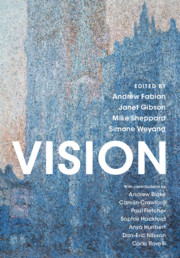78 results
Utility of Repeat Endpoint Quaking-Induced Conversion Testing in Creutzfeldt–Jakob Disease
-
- Journal:
- Canadian Journal of Neurological Sciences / Volume 50 / Issue 6 / November 2023
- Published online by Cambridge University Press:
- 24 October 2022, pp. 929-931
-
- Article
-
- You have access
- Open access
- HTML
- Export citation
Virtual engagement of under-resourced communities: Lessons learned during the COVID-19 pandemic for creating crisis-resistant research infrastructure
-
- Journal:
- Journal of Clinical and Translational Science / Volume 6 / Issue 1 / 2022
- Published online by Cambridge University Press:
- 04 April 2022, e44
-
- Article
-
- You have access
- Open access
- HTML
- Export citation
Contents
-
- Book:
- Vision
- Published online:
- 17 September 2021
- Print publication:
- 26 August 2021, pp ix-ix
-
- Chapter
- Export citation

Vision
-
- Published online:
- 17 September 2021
- Print publication:
- 26 August 2021
Figures
-
- Book:
- Vision
- Published online:
- 17 September 2021
- Print publication:
- 26 August 2021, pp x-xix
-
- Chapter
- Export citation
Dedication
-
- Book:
- Vision
- Published online:
- 17 September 2021
- Print publication:
- 26 August 2021, pp vii-viii
-
- Chapter
- Export citation
Copyright page
-
- Book:
- Vision
- Published online:
- 17 September 2021
- Print publication:
- 26 August 2021, pp vi-vi
-
- Chapter
- Export citation
Notes on Contributors
-
- Book:
- Vision
- Published online:
- 17 September 2021
- Print publication:
- 26 August 2021, pp xx-xxiii
-
- Chapter
- Export citation
Index
-
- Book:
- Vision
- Published online:
- 17 September 2021
- Print publication:
- 26 August 2021, pp 197-204
-
- Chapter
- Export citation
Acknowledgements
-
- Book:
- Vision
- Published online:
- 17 September 2021
- Print publication:
- 26 August 2021, pp xxiv-xxiv
-
- Chapter
- Export citation
A distributed geospatial approach to describe community characteristics for multisite studies
-
- Journal:
- Journal of Clinical and Translational Science / Volume 5 / Issue 1 / 2021
- Published online by Cambridge University Press:
- 05 February 2021, e86
-
- Article
-
- You have access
- Open access
- HTML
- Export citation
Novel method of calculating adjusted antibiotic use by microbiological burden
-
- Journal:
- Infection Control & Hospital Epidemiology / Volume 42 / Issue 6 / June 2021
- Published online by Cambridge University Press:
- 28 January 2021, pp. 688-693
- Print publication:
- June 2021
-
- Article
- Export citation
Stratifying major depressive disorder by polygenic risk for schizophrenia in relation to structural brain measures
-
- Journal:
- Psychological Medicine / Volume 50 / Issue 10 / July 2020
- Published online by Cambridge University Press:
- 18 July 2019, pp. 1653-1662
-
- Article
-
- You have access
- Open access
- HTML
- Export citation
The Garboldisham Macehead: its Manufacture, Date, Archaeological Context and Significance
-
- Journal:
- Proceedings of the Prehistoric Society / Volume 83 / December 2017
- Published online by Cambridge University Press:
- 04 October 2017, pp. 383-394
- Print publication:
- December 2017
-
- Article
- Export citation
Field Presence of Glyphosate-Resistant Horseweed (Conyza Canadensis), Common Lambsquarters (Chenopodium Album), and Giant Ragweed (Ambrosia Trifida) Biotypes with Elevated Tolerance to Glyphosate
-
- Journal:
- Weed Technology / Volume 22 / Issue 3 / September 2008
- Published online by Cambridge University Press:
- 20 January 2017, pp. 544-548
-
- Article
- Export citation
Verbal Initiation, Suppression, and Strategy Use and the Relationship with Clinical Symptoms in Schizophrenia
-
- Journal:
- Journal of the International Neuropsychological Society / Volume 22 / Issue 7 / August 2016
- Published online by Cambridge University Press:
- 22 June 2016, pp. 735-743
-
- Article
- Export citation
Beaker people in Britain: migration, mobility and diet
- Part of
-
- Article
-
- You have access
- HTML
- Export citation
5 - ‘A New Mode of the Existence of Truth’: Rancière and the Beginnings of Modernity 1780–1830
- from SECTION I - Coordinates
-
-
- Book:
- Rancière and Literature
- Published by:
- Edinburgh University Press
- Published online:
- 15 September 2017
- Print publication:
- 11 May 2016, pp 99-122
-
- Chapter
- Export citation
Contributors
-
-
- Book:
- The Cambridge Dictionary of Philosophy
- Published online:
- 05 August 2015
- Print publication:
- 27 April 2015, pp ix-xxx
-
- Chapter
- Export citation
Index
-
- Book:
- Concepts of Creativity in Seventeenth-Century England
- Published by:
- Boydell & Brewer
- Published online:
- 05 March 2014
- Print publication:
- 21 November 2013, pp 343-354
-
- Chapter
- Export citation



